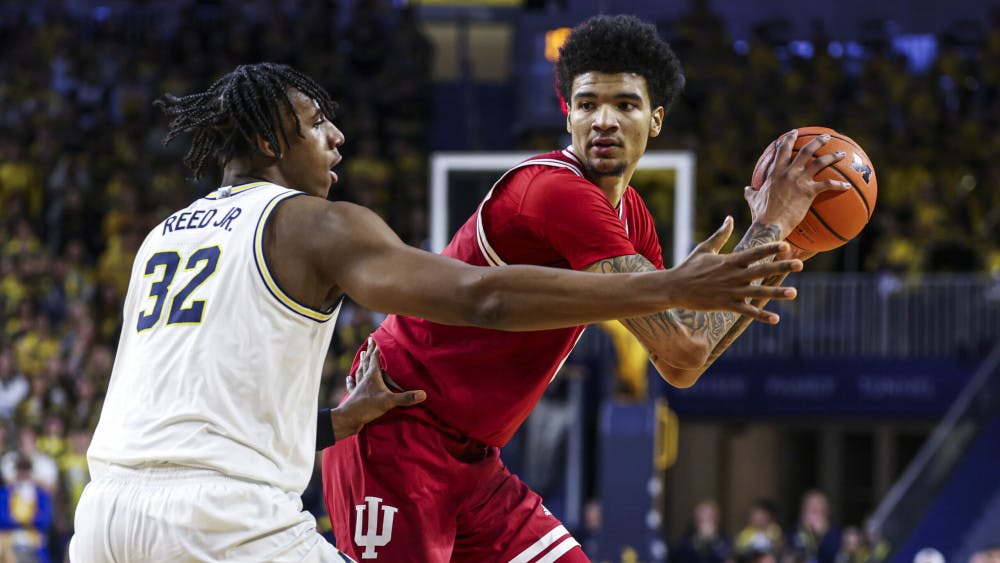Indiana took a road trip up to Ann Arbor and brought back a victory, 78-75, in its first true road game of the season. The win was the Hoosiers fourth straight against Michigan and gave them their first 2-0 start in Big Ten Conference play since the 2018-19 season.
Here are three takeaways from the win.
Paint points still dominant in Big Ten play
Indiana has relied on the two point shot all season. The outside shooting woes have been evident. Indiana came into the game shooting just 25% from three this season, 351st in the nation. However, IU has been really good inside the arc, converting 58.1% of their two point shots heading into the day.
That trend did not change. Indiana put up 52 points in the paint gainst Michigan, good for 67% of their total points for the game. The Hoosiers only attempted 9 three point shots, making three of them (the exact same made and attempted as the previous game against Maryland).
It was clearly their gameplan, especially in the second half. Hoosier guards were consistently looking inside for post ups for Kel’el Ware and Malik Reneau, who combined for 28 points on 12-21 shooting on the evening.
Ware had the ball in his hands at the end of the game, giving Indiana their go-ahead basket on a running hook shot with 53 seconds left.
“He made a hell of a move, man,” Indiana Head Coach Mike Woodson said. “I mean, to drop that bucket in, and I thought that was the difference in us securing the win, because we needed a big bucket in that particular time.”
Michigan is not a great defensive team, ranking just 132nd in the country in defensive efficiency on Kenpom.com after the loss. But, they do play two 6-10 forwards in Tarris Reed Jr. and Tray Jackson as well as 6-9 Olivier Nkamhoua, and the Indiana big men were still able to get buckets in the paint.
Turnovers and sloppy offense are still problems
While Indiana was still able to get buckets in the paint, the offense was not smooth for all 40 minutes. The Hoosiers went on a scoring drought of over four minutes in the second half. The Indiana offense got stagnant. Guards were circling the perimeter, looking for post passes without much success.
The lack of offensive flow kept Indiana to just 14 points in the first 10 minutes of the second half after putting up 37 in the first frame.
Turnovers were also a problem, specifically in the first half, where the Hoosiers had 10. The turnovers wound up not hurting them as much as they could have, as Michigan ended the game with 14 turnovers to Indiana’s 13, and still had nine in the first half. However, the errant passes and sloppy ball control could come back to bite the Hoosiers in the future.
The bench provided a spark in bit time moments
The Indiana bench put up 28 points and brought the necessary energy in key moments of the game.
CJ Gunn, knocked down two three-pointers, the first game of his career with multiple three-pointers made. One came in a key moment, with 7:30 left in the second half to give Indiana a 60-59 lead. The sophomore guard was also active on the defensive end of the floor, picking up four steals in his 20 minutes of action.
“It’s amazing,” Gunn said. "You know, I’ve been waiting for this game. This is just proof of the work that I’ve been putting in.”
“He was great,” Woodson said. “I mean, he made shots. Defensively he was in tune.”
The rest of the bench unit all had their fingerprints on the game as well, with Kaleb Banks, Payton Sparks, and Anthony Walker all scoring at least 6 points (including a 4-4 night from the field for Walker).
With Xavier Johnson out with an injury, the Indiana bench provided the depth the Hoosiers needed to secure the victory in their first Big Ten road game.
Indiana takes the floor next against Auburn in Atlanta on Saturday at 2pm.










